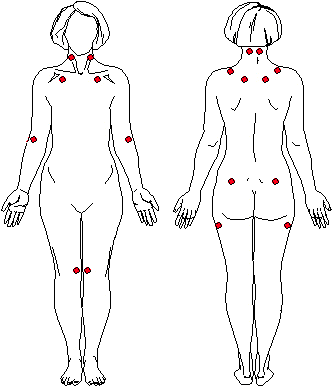 VISITOR SINCE JUNE 10, 1998.
VISITOR SINCE JUNE 10, 1998.
 VISITOR SINCE JUNE 10, 1998.
VISITOR SINCE JUNE 10, 1998.
| Please Sign My Guestbook |

| Feel Free to View Guestbook |
Fibromyalgia Syndrome (FMS) is pronounced "fie-bro-my-al-jia sind-rome." The word "fibromyalgia" is a combination of the Latin roots "fibro" (connective tissue fibers), "my" (muscle), "al" (pain), "gia" (condition of). The word syndrome simply means a group of signs and symptoms that occur together which characterize a particular abnormality.
Fibromyalgia is not a new syndrome. It was first described by William Balfour, a surgeon at the University of Edinburgh, in 1816 (van Why, 1994), but for many years the medical profession called it many different names, including chronic rheumatism, myalgia, pressure point syndrome, and fibrositis, and the condition was also thought to be psychological by some physicians. In other words, the prevailing belief was that "it was all in your head" or "it was your own fault you were sick.
In 1987, The American Medical Association (AMA) recognized FMS as a true illness and a major cause of disability. Now, nearly ten years later, it is still, unfortunately, too often dismissed as the "newest fad disease", and most physicians still lack the diagnostic skills needed to differentiate it from chronic pain conditions. In fact, until recently, it was rare to find a doctor who had even heard of FMS as a "real" condition, and very few doctors have received any substantial training in treating the syndrome.
Many physicians are defensive about their lack of training in this field and there are some who still refuse to acknowledge that FMS (and (MPS) really exist. You many have encountered such practitioners. Fortunately, this attitude is becoming less common.
The average FMS patient suffers for five years and spends thousands of dollars on medical bills before receiving an accurate diagnosis. As a result of misdiagnosis, more than half of all patients undergo unnecessary surgery.
It isn't unusual for those who are fibromyalgia patients to feel a profound sense of relief when they learn they have a recognized illness and they come to understand that it isn't progressive.
If this has been your experience, you may cry with relief at not having to doubt yourself any longer. At last, someone believes in you. You really do have these symptoms, and you are no longer fighting the world alone.
Admittedly, if your doctor has no specific training in FMS, his or her initial diagnosis can be extremely difficult. Patients can exhibit different symptoms at every visit, which often do not appear to be related to each other. These run the gamut from sleep problems, blurred vision, falling, itching, and pelvic pain to hearing loss, and soft tissue aches and pains. The list sometimes seems endless. Many patients don't even tell their doctors all of their symptoms because they sense the doctor's disbelief.
With FMS, the standard medical tests can come back negative, and the doctor can become very frustrated. The patient may look fine, but he or she has constant, unsubstantiated complaints. To make things even more confusing, the signs and symptoms can, and frequently do, fluctuate from hour to hour and day to day.
In desperation, many doctors often send their patients to physical therapy or for psychological counseling. Yet, most often, every treatment a person with FMS tries only aggravates the symptoms further.
It is important to understand that FMS is not a catch-all, "wastebasket" diagnosis. "FMS" is a specific, chronic non-degenerative, non-progressive, non-inflammatory, truly systemic pain condition - a true syndrome" (van Why, 1994). Very recently, however, the National Institutes of Health have reclassified it as a true disease, but most authorities today still say that, technically, FMS is not a disease. Diseases have know causes and well-understood mechanisms for producing symptoms. Instead, FMS is called a syndrome, which means it is a specific set of signs and symptoms that occur together.
Don't let this categorization fool you into thinking that fibromyalgia is any less serious or potentially disabling than a "disease". Rheumatoid arthritis, lupus, and other serious afflictions are also classified as syndromes.
The essential symptom of FMS is pain except in the case of elderly patients. Older patients are more troubled by fatigue and depression. In younger people, discomfort after minimal exercise, low-grade fever or below-normal temperature, and skin sensitivity are also common.
Laboratory tests for fibromyalgia are valid only to rule out other conditions. At present, there is still no blood test that can accurately identify fibromyalgia.
Unfortunately, although some doctors claim to have a blood test for it, thousands of dollars worth of blood tests later, their patients still have received no diagnosis. Then, these doctors often send their patients to see psychiatrists, because "nothing showed up in the blood test, so therefore nothing can be wrong." Unfortunately, until physicians learn to ask the right questions, they will be unable to provide the right answers.
The official definition of fibromyalgia came about as a result of the Copenhagen Declaration, which established fibromyalgia as an officially recognized syndrome on January 1, 1983, for the World Health Organization. This definition was presented at the Second World Congress on Myofascial Pain and Fibromyalgia, which was held in Copenhagen in 1992.
The Copenhagen Declaration defines FMS as a painful, but not articular (not present in joints), condition predominantly involving muscles, and as the most common cause of chronic, widespread musculoskeletal pain.
The diagnostic fine points of FMS had been defined (van Why, 1994) by the American College of Rheumatology (ACR) in 1990. The World Health Organization considered the ACR definition as "suitable for research purposes" and added the following symptoms to the syndrome. (Note that these are often overlooked.)
"...the presence of unexplained widespread pain or aching, persistent fatigue, generalized morning stiffness, non-refreshing sleep, and multiple tender points. Most patients with these symptoms have 11 or more tender points. But a variable proportion of otherwise typical patients have less than 11 tender points at the time of examination.
In addition, the Copenhagen Declaration states that fibromyalgia syndrome is "part of a wider syndrome encompassing headaches, irritable bladder, dysmenorrhea, cold sensitivity, Raynaud's phenomenon, restless legs, atypical patterns of numbness and tingling, exercise intolerance and complaints of weakness."
The Copenhagen Declaration goes on to state that the psychological state of FMS patients, which is often one of depression and anxiety, could well be caused by the physical conditions. Chronic pain, especially pain of undiagnosed origin, is a frequent source of depression and anxiety.
Lately, there have been some educational articles about FMS in the popular press. This has alerted many patients to the true nature of their problem. For example, one member of a local support group had been seeing a specialist for some time, without receiving a diagnosis. She took one of these articles to her doctor and told him, "This is what I have. It's fibromyalgia." His response was, "I've known that for two years. I didn't tell you, because there's nothing you can do about it anyway." This physician's attitude has no place in the practice of medicine - nor anywhere else. There are effective treatments for FMS, and he owed it to his patient to inform her of her correct diagnosis. Anything short of that is unethical.
The Copenhagen official Fibromyalgia Syndrome definition states that you must have at least 11 of the 18 specified tender points to be diagnosed with FMS. Tender points hurt where pressed, but they do not refer pain elsewhere--that is, pressing a tender point does not cause pain in some other part of the body. (Note that when examining yourself for tender points, you must use enough pressure to whiten the thumbnail.)
The official definition further requires that tender points must be present in all four quadrants of the body--that is, the upper right and left and lower right and left parts of your body. (See Graphic below) Furthermore, you must have had widespread, more-or-less continuous pain for at least three months. Because tender points can fluctuate and vary from day to day, if you don't have "11 out of the 18" on a given day, you doctor may diagnose "possible FMS" and may need to count the tender points on future visits.
As the graphic below shows, tender points occur in pairs on various parts of the body. Because they occur in pairs, the pain is usually distributed equally on both sides of the body. Note, however, that the tender point locations shown in this diagram are not "written in stone." They can vary from person to person, which can cause further problems with diagnosis. In traumatic FMS, for example, tender points are often clustered around an injury instead of, or in addition to, the 18 "official" points. These clusters can also occur around a repetitive strain or a degenerative and/or inflammatory problem, such as arthritis.

| Condition | % of FMS Symptoms |
|---|---|
| Muscular Pain | 100 |
| Fatigue | 96 |
| Insomnia | 86 |
| Joint Pains | 72 |
| Headaches | 60 |
| Restless Legs | 56 |
| Numbness and Tingling | 52 |
| Impaired Memory | 46 |
| Leg Cramps | 42 |
| Impaired Concentration | 41 |
| Nervousness | 32 |
| Depression (Major Depression) | 20 |
The above picture and table information was obtained from the:
National Fibromyalgia Research
Association, PO Box 500, Salem, OR 97302
Knowledge, as they say, is power. This is especially true with fibromyalgia syndrome. The more you know about it, the better able you will be to deal with it.
FMS can occur at any age. Most patients, when questioned carefully, reveal that their symptoms began at an early age. Often the first sign is "growing pains".
Pain is frequently the most prominent symptom of FMS, but there are many others. For example, your eyes may often be too dry, but at other times, they will water. Your thermal regulatory system is out of whack. You may notice this thermal fluctuation when you get out of bed (often due to bladder irritability) during the night. You may have to wait for your temperature to cool down after getting back in bed, befor you can pull the bedcover up again.
Another symptom of FMS is spasticity (tightness) which can constrict the peripheral blood vessels--those close to the skin. This symptom, especially in winter, makes certain parts of our bodies--most often the buttocks and thighs--feel like cold slabs of meat.
You may experience skin mottling, and nail ridges. Fingernails can break off, often in crescent-shaped pieces. If nails do grow, they sometimes start to curve under.
Often FMS is found coexisting with one or more other disorders, and FMS may also amplify the symptoms of another disorder.
FMS adds stress to everything we do. Many fibromites cannot sit still or maintain any other position for longer than 20 minutes without becoming stiff. Morning stiffness can take an hour or more to wear off.
The course of FMS can be mild, moderate, or severe. In some cases, there are remissions (van Why, 1994). Nearly everyone with FMS exhibits reduced coordination skills and decreased endurance abilities. FMS can be as disabling as rheumatoid arthritis. Approximately 30 percent of FMS patients cannot hold down jobs due to their chronic, unrelenting symptoms (Wolfe, 1989). It often creeps up, one symptom at a time. The person with FMS learns to live with those symptoms until his or her quality of life becomes serously compromised.
It appears the tendency to develop FMS is inherited.
The bad news is that a study by Pellegrino, Waylonis, and Sommer (1989a) at Ohio State found that FMS is inherited on an "autosomal dominant basis." This means that approximately half of the children of an FMS parent will eventually develop FMS.
FMS is a sensitivity-amplification syndrome. Because of this it has been called the "Irritable Everything Syndrome". This means that fibromites are sensitive to smells, sounds, lights, and vibration. The noise emitted by fluorescent lights can drive them crazy.
FMS sensitizes nerve endings, which means that the ends of the nerve receptors have changed shape. Because of this, for example, your body might interpret "touch, light, or sound" as "pain". Your brain knows pain is a danger signal--an indication that something is wrong and needs attention--so it mobilizes its defenses. For example, adrenaline starts pumping and your muscles tense, ready for "fight" or "flight" action. Your heart speeds up. Blood flow slows to areas that are not immediately needed for action, such as your digestive tract, but blood flow to your muscles increases. Then, when those defenses aren't used (or when no action is taken) the body/mind system becomes anxious.
Frequently, for fibromites, the pain does not indicate a dangerous situation. But our bodies are getting the wrong signals. Pain itself causes stress and depression, which may cause further contratcion and then more pain. The pain signal is an indication that it's time to do something about the problem.
Sleep plays a curcial role in FMS. Perhaps you aren't getting enough sleep, or the right "kind" of sleep. You may have insomnia, or a host of other sleep-related problems.
Much of our mental and physical sense of continuity and security as fibromites depends on our ability to repeat appropriate and predicatable actions, but this ability is disrupted in FMS. Neurotransmitters, which are the biochemical substances that transmit nerve impulses across synapses, normally inform our muscles constantly about what they're doing so that their actions can be modified. For fibromites, much of our muscle tension function is improperly controlled by these neurotransmitters.
Healthy people think nothing of picking up a glass of water and bringing it to their lips. They know just how tightly their hand has to maintain a grip, how heavy the glass of water feels, and how much speed is appropriate to accomplish this act smoothly. Fibromites, however, lack proper sensory feedback. Their thumbs grasp with too little pressure, and their wrist muscles let go when flexed. The economy of effort is not there. To enable us to sit, walk, and stand, the entire musculature must be able to feel its own activity accurately.
In FMS, a triggering event often activates biochemical changes, causing a cascade of symptoms. For example, unremitting grief of six months or longer can trigger FMS. It's sort of like "Survivor's Syndrome." Cumulative trauma, protracted labor in pregnancy, open-heart surgery, or even inguinal hernia repair have all been triggering events for FMs. Life stressors can overwhelm the body's balancing act, turning life itself into an endurance contest.
Note, however, that only about 20 percent of FMS cases have a known triggering event that initiates the first obvious flare. During a flare, current symptoms become more intense, and new symptoms frequently develop.
There are some myths about FMS that must be silenced. The following list is adapted from Richard van Why's work. Van Why is a nurse and massage therapist, who give excellent weekend courses on fibromyalgia for massage therapists. Doctors and patients are invited to attend his seminars. He's one of our FMily, and a fountain of knowledge.

This implies that it may not really exist. The American College of Rheumatology, American Medical Assocaition, World Health Organization, and the National Institutes of Health have all accepted FMS as a legitimtate clinical entity. There is no excuse for doctors "not believing" in its reality. It's real.

True, is isn't malignant. But "benign" is often wrongly translated as "harmless and easy to live with." FMS is neither.

Studies have shown that the incidence of mental problems is no higher with FMS patients than with any other type of chronic pain syndrome.

Not yet, although there are a lot of researchers working on it. On a more positive note, there are ways to achieve a remission of symptoms.
As an FMS patient, you have probably been burdened with a long history of undiagnosed illness. Because your condition is more or less invisible, friends and family may not believe you when you say you hurt, so you may also be suffering from a loss of self-esteem. In other words, you may be deprived of the normal support network that forms around a chronically ill person because "you look just fine". And without the support of family and friends, you may well withdraw from others to conserve what little self-esteem and energy you have left. There are a number of techniques available to help you pull yourself out of this box.
The difficulties you may encounter when dealing with government and insurance services to receive the support you need can further contribute to your loss of self-esteem and can complicate work and economic issues.
Then there's also the issue of dealing with the furnishings and people in your workplace. A lot of how you are accommodated there is up to you. There are ways you can make your workplace less stressful.
This has been a brief look at the basic components of FMS and have touched on some of the difficulties that having FMS creates in our lives. The good news is that there are many tools that area available to help you create your own personal health care system and to improve the quality of your life. These include support groups, exercises, bodywork, relaxation techniques, and organizational skills.
It's time for an attitude adjustment.



| Back to the Top | Mae's Health Page | Mae's Home Page | All About Mae |

| LINKS TO OTHER RESOURCES ON FIBROMYALGIA |

|
![American Fibromyalgia Syndrome Association [AFSA]](afsalogosm.gif)
American Fibromyalgia Syndrome Association [AFSA]

Fibromyalgia Information From the Oregon Fibromyalgia Foundation

ANADEM - Fibromyalgia and Chronic Conditions Publications
![Missouri Arthritis Rehabilitation Research and Training Center [MARRTC]](main.jpg)
Missouri Arthritis Rehabilitation Research and Training Center [MARRTC]

National Fibromyalgia Partnership, Inc.

Fibrohugs Fibromyalgia Support Site

Fibromyalgia & Chronic Myofascial Pain

National Fibromyalgia Association

Arthritis Foundation: Fibromyalgia - What is it?

American College of Rheumatology Fibromyalgia Fact Sheet

David Nye, M.D. - Fibromyalgia FAQ For Patients

Chronic Fatigue Syndrome & Fibromyalgia Information Exchange Forum

Immune Support Home - Fibromyalgia & Chronic Fatigue Syndrome

About.Com - Chronic Fatigue Syndrome/Fibromyalgia

National Fibromyalgia Research Association: An Answer to Fibromyalgia - What is it?

Fibromyalgia - Neurology Channel: (pic = hdr_neu_top.gif)

Hypermobility and Fibromyalgia Website

Absolutely Everything You Need To Know About Fibromyalgia

Managing Fibromyalgia: A Non-Medical Approach

Dr. Lamb: Is There a Cure For Fibromyalgia?

American Academy of Family Phyisicians - Treating Fibromyalgia

American Academy of Family Phyisicians - Treating Fibromyalgia

Health World Online Article - Fibromyalgia: The Muscle Pain Epidemic

Fibromyalgia - A New Perspective

National Institute for Arthritis and Musculoskeletal and Skin Diseases - Q&A on Fibromyalgia
![Chronic Fatigue and Fibromyalgia: Ask NOAH [New York Online Access To Health]](home.gif)
Chronic Fatigue and Fibromyalgia: Ask NOAH [New York Online Access To Health

American Academy of Family Phyisicians - Fibromyalgia and Exercise

Fibromyalgia: What Is It and How to Manage It

Help for Fibromyalgia: Supplementing substances found naturally in the human body

The National Women's Health Information Center - Fibromyalgia

Center for Medical Enlightenment: Fibromyalgia Discovery
 Email Mae
Email Mae
| Back to the Top | Mae's Health Page | Mae's Home Page | All About Mae |